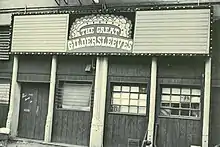The Great Gildersleeves
The Great Gildersleeves was a hard rock and punk rock club at 331 Bowery in Manhattan.[1][2] The club opened in August 1977 and closed in February 1984 after the building in which the club was located was taken by eminent domain by the New York City Board of Estimate.[3] It was the first time that a private property was taken by eminent domain by the City of New York for use as a shelter for the homeless.[4] The City's action followed a rent dispute between the owner of the building and the City, which leased three of the upper floors of the building that were operated as the Kenton Hotel to house approximately 200 homeless men. Following condemnation by the City, the building became a flophouse before being taken over by Project Renewal as the Kenton Hall Men's Shelter and used as a shelter for homeless men on methadone maintenance.[5][6] It was named after a radio show, The Great Gildersleeve.
Gildersleeves | |
 Front of The Great Gildersleeves, early 1980's | |
| Location | 331 Bowery, New York City, NY 10003 |
|---|---|
| Capacity | 500 |
| Opened | August 1977 |
| Closed | February 1984 |
Bands who performed at The Great Gildersleeves included The J. Geils Band, Molly Hatchett, Elvis Costello, Hall & Oates, Elvin Bishop, Iggy Pop, Anthrax, Beastie Boys, Public Image Ltd, Sonic Youth, and Blue Angel (featuring Cyndi Lauper).
On April 1, 1979, Elvis Costello and The Attractions performed three concerts on a single evening in New York City, including a concert at The Great Gildersleeves.[7]
On April 27, 1980, The J. Geils Band performing under the name Juke Joint Jimmy & His House Party Rockers recorded the song "Love Stinks" live at The Great Gildersleeves which was later released as a 12" promo by EMI.
The music video for the song "Dead Ringer for Love" performed by Meat Loaf and Cher was filmed at The Great Gildersleeves in 1981.
An album titled "Best of Great Gildersleeves" was released that featured bands who regularly performed at The Great Gildersleeves.
In 2000, the band Danger Danger named its album The Return of the Great Gildersleeves in tribute to the venue.
The Great Gildersleeves is referenced in the application for The Bowery Historic District.[8]
References
- Palmer, Robert (1977-04-15). "A New Life for the Bowery". The New York Times. ISSN 0362-4331. Retrieved 2020-06-10.
- Rockwell, John (1979-09-30). "Bands From the Los Angeles Club Circuit". The New York Times. ISSN 0362-4331. Retrieved 2020-06-10.
- Dunlap, David W. (1984-01-27). "Taking Hotel for Homeless Approved". The New York Times. ISSN 0362-4331. Retrieved 2020-06-11.
- Dunlap, David W. (1984-01-13). "Use of Bowery Hotel for Homeless Opposed". The New York Times. ISSN 0362-4331. Retrieved 2020-06-11.
- Mike Katz; Crispin Kott; Legs McNeil (2018), Rock and Roll Explorer Guide to New York City, Rowman & Littlefield, p. 149, ISBN 9781493037049
- Frank Mastropolo (4 February 2013), "Rock Meccas of NYC: What Are They Now?", Rock Cellar
- Guardian Staff (2008-05-30). "Rumble in the Bowery". The Guardian. ISSN 0261-3077. Retrieved 2020-06-10.
- "The Bowery Historic District". www.nps.gov. Retrieved 2020-06-12.